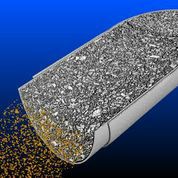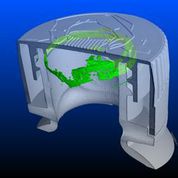Addressing Manufacturing Challenges with Nondestructive X-Ray Imaging
Greater sophistication in 3D X-ray imaging technology raises its utility for QA/QC in manufacturing.
For pharmaceutical manufacturers, finding the cause of product-quality failures and ensuring product quality are crucial, and various methods can be used. Industrial X-ray imaging is used in the pharmaceutical industry in a variety of ways, from product-integrity and materials-distribution analysis to improving product-delivery methods and the integrity of packaging. It is also used to address manufacturing challenges that may occur in the hardware and machinery of a pharmaceutical manufacturing plant. In short, industrial X-ray imaging can be used to provide an inside perspective of a product or the mechanisms used to produce that product.
Two primary modes
There are two primary modes of industrial X-ray imaging. The first is two-dimensional (2D) digital radiography, which involves capturing static or in-motion "real-time" images of the inside of an object (or living organism) by passing X-rays through that product and capturing them on a digital detector. “This technique is often used for the simple detection of foreign materials and contaminants in a product. It is also effective for investigating the distribution of materials within a delivery device, such as looking at a drug inside of a syringe, or the active ingredients and excipients in a solid dosage form,” says Jeffrey Diehm, comanaging director of Avonix Imaging, a provider of industrial X-ray and computed tomography (CT) imaging services and systems.
The second, more advanced X-ray imaging technology used in the pharmaceutical industry is three-dimensional (3D) computed tomography imaging. With this method, the same X-ray imaging technology that is used for 2D imaging is also used, except that instead of capturing a single static image, the sample is rotated 360 degrees while capturing a series of images. These images are then "reconstructed" into a true three-dimensional representation of the internal and external features of the sample. “This imaging method is quite valuable because it provides the only means for capturing the internal geometric data of a sample as well as the density distribution within,” asserts Brian Ruether, Diehm’s business partner and resident technical expert.
Nondestructive and more
The most common uses for X-ray imaging in the pharmaceutical industry include process and design verification, product-quality analysis, foreign-material determination (metal, glass, organics), fill-level confirmation, and missing-components detection. These analyses are applied to the various types of solid and semisolid dosage forms, including tablets, capsules, and gel caps. Packaging materials–from medicine bottles to syringes–can also be evaluated using digital X-ray and computed tomography.
One of the main advantages of X-ray imaging is that it is a nondestructive analytical technique. Its depth of penetration and reasonably high resolution are also critical aspects of the technology that make it very useful for pharmaceutical analysis. There are no other methods that can define the internal geometry of an object or provide a true three-dimensional view of a finished product in a nondestructive manner, according to Ruether. In addition, he points out that X-ray imaging offers high internal and external dimensional accuracy and the ability to distinguish between materials of varying densities within a sample while also being fast and cost-effective.
The importance of distribution
X-ray imaging can be used to determine the thickness of layers in multilayer tablets and the shape and size of the interface between layers, investigate the microstructure of fast-dissolving tablets and the features of embossed markings on tablet surfaces, evaluate the morphology and pore-size distribution of granules, and identify defects in compacted tablets.

In addition, as long as the materials that comprise individual pills and capsules generate sufficient X-ray contrast, high-resolution computed tomography can be used to determine the distribution of the ingredients (APIs and/or excipients) throughout the pill or capsule by segmenting the components by size and/or density (see Figure 1). The higher energy of the X-rays enables them to readily penetrate most pharmaceutically relevant excipients and APIs. In addition, with the short-wavelength radiation, it is possible to get high-resolution images with minimal diffraction.
The information available from such an analysis can be used for several purposes. Comparative evaluation of the internal structures of two supposedly branded tablets using X-ray imaging can, for example, be used to identify counterfeit products without damaging the questionable tablets. Changes in the structure of solid and semisolid drug products over time (i.e., during storage) or under different stresses can also be identified using X-ray imaging.
Even the performance of manufacturing processes can be evaluated, and potential sources of product-quality inconsistencies identified. In one case, a pharmaceutical company observed that a drug product produced at different manufacturing sites exhibited inconsistent efficacy depending on the production location, according to Diehm. To determine the cause of the variation, X-ray imaging was used to evaluate the level of crystallinity of the interior of tablets manufactured at each site because the API was crystalline while the binder was not. “Using high-resolution CT scans, we were able to determine that there was a significant quantifiable difference in the makeup of the pills coming from the different plants. This information was used by the manufacturer to modify the manufacturing process and achieve a higher level of consistency between plants,” he explains.
Improving delivery and packaging systems
X-ray inspection in pharmaceutical manufacturing can also be used to simultaneously inspect products for multiple quality control issues, which safeguards the integrity of the drug product and brand while ensuring regulatory compliance, according to Diehm. In addition to formulated dose analysis, X-ray imaging can be used to detect product defects ranging from insufficient fill levels to damaged seals to misshapen containers to missing components (See Figure 2). “We have worked with pharmaceutical clients to identify the sources of inconsistencies in their manufacturing processes and help them validate process improvements in order to ensure that the products being produced meet the stringent requirements of the industry,” he comments.

For one pharmaceutical company, Avonix Imaging used X-ray analysis to identify the cause of inconsistencies in the delivery performance of their syringes. Variation in the syringe- manufacturing process was resulting in patients not receiving the prescribed dosage of liquid in the right amount of time. “By analyzing CT scans of the syringes, it was determined that there was not only a difference in the inside diameter of the needle but, more importantly, there was also an inconsistency in the shape of the syringe opening, which sometimes resulted in the formation of a small burr or ridge that led to the inconsistency in the flow rate,” Diehm says. With this information, the company was able to modify the manufacturing process and eliminate these issues.
Even minor flaws in basic product packaging can cause real problems for drug manufactures and their customers. In many cases, X-ray imaging can help identify these defects as well. Diehm offers a case in point from a liquid antacid manufacturer that was having a problem with the sealing of one of its bottles, which benefited from the technique. In this example, the defective seals were leading to leakage once the bottles were opened for the first time. Avonix Imaging scanned numerous bottles made using different plastic molds and found variation in the wall thickness of the bottle at the top surface. “This thickness variation made it difficult to properly seal the bottle unless enough force was applied, which was often difficult for elderly patients in particular. Here again, using the dimensional information provided by the CT scans, it was possible to identify the source of the problem. As a result, the manufacturer changed the problem molds and gained more control over its process.”
Improvements may lead to in-line use
Recent advances in X-ray imaging technology have included new, higher-resolution X-ray tube and imaging detector combinations, along with stronger computing platforms, which enable the imaging of smaller internal features. In addition, advanced 3D analysis software can now provide automated void and particle-density distribution calculations from the CT data, according to Ruether.
Currently, the one major limitation of X-ray imaging is that it is not ideally suited yet for in-line analysis, particularly for certain features of interest. “The technology is constantly evolving, though,” stresses Ruether. “Higher-resolution and higher-speed detectors, in combination with advancements, in software analysis will help overcome the issues that are limiting the use of X-ray analysis in production environments.”
Additionally, education will encourage further adoption of X-ray imaging technology. “Our main goal is to help educate the pharmaceutical industry about how Xray and CT imaging can be used as a tool for overcoming the challenges that drug manufacturers face every day,” Diehm says. “As they learn more and see first-hand how they can improve the quality and consistency of their products through the use of X-ray imaging technology, they begin to think of other manufacturing challenges that might be better addressed through the use of this nondestructive method," he observes.